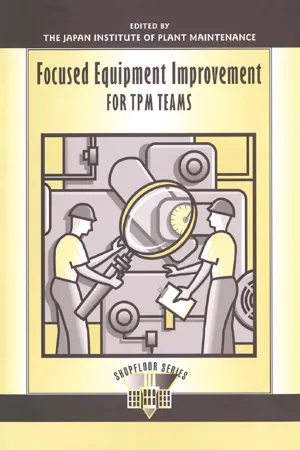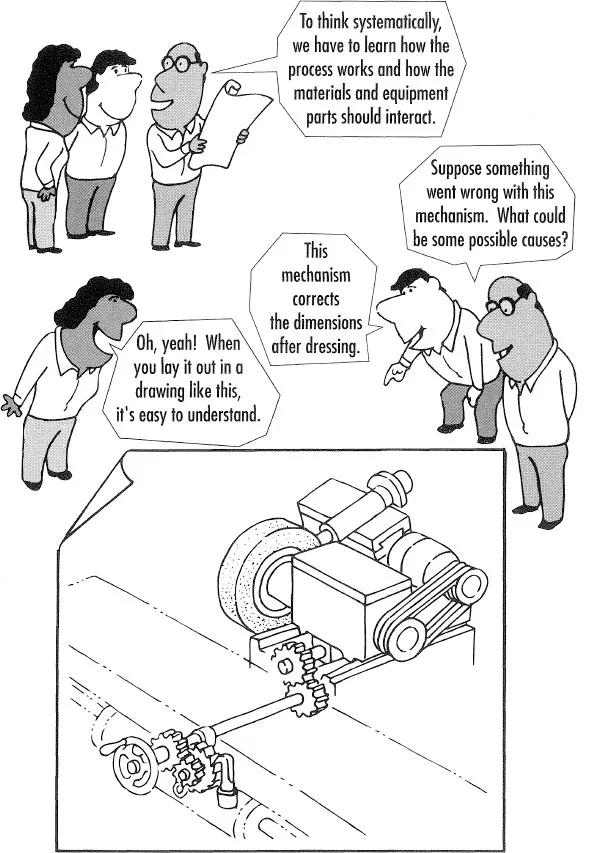
eBook - ePub
Focused Equipment Improvement for TPM Teams
This is a test
- 142 pages
- English
- ePUB (mobile friendly)
- Available on iOS & Android
eBook - ePub
Focused Equipment Improvement for TPM Teams
Book details
Book preview
Table of contents
Citations
About This Book
As distinguished from autonomous maintenance, where the main goal is to restore basic conditions of cleanliness, lubrication, and proper fastening to prevent accelerated deterioration, FEI looks at specific losses or design weaknesses that everyone previously thought they just had to live with. Once your TPM operator teams are progressing with their daily autonomous maintenance activities, you will want to take the next advanced step in TPM training with this book.
Key Features:
- a simple and powerful introduction to P-M Analysis
- hints for unraveling breakdown analysis
- numerous ideas for simplifying and shortening setups
- ideas for eliminating minor stoppages and speed losses
- basic concepts of building quality into processing
- real-life examples from a leading Japanese tool company
Frequently asked questions
At the moment all of our mobile-responsive ePub books are available to download via the app. Most of our PDFs are also available to download and we're working on making the final remaining ones downloadable now. Learn more here.
Both plans give you full access to the library and all of Perlego’s features. The only differences are the price and subscription period: With the annual plan you’ll save around 30% compared to 12 months on the monthly plan.
We are an online textbook subscription service, where you can get access to an entire online library for less than the price of a single book per month. With over 1 million books across 1000+ topics, we’ve got you covered! Learn more here.
Look out for the read-aloud symbol on your next book to see if you can listen to it. The read-aloud tool reads text aloud for you, highlighting the text as it is being read. You can pause it, speed it up and slow it down. Learn more here.
Yes, you can access Focused Equipment Improvement for TPM Teams by Japan Institute of Plant Maintenance, Japan Institute of Plant Maintenance, JapanInstituteofPlantMaintenance in PDF and/or ePUB format, as well as other popular books in Business & Operations. We have over one million books available in our catalogue for you to explore.

Thinking Systematically
CHAPTER 1
CHAPTER OVERVIEW
Thinking Systematically
• What It Means to Think Systematically
• Form a Clear Picture of What’s Going On
• Explain the Situation in Physical Terms
• Think about the Conditions Influencing the Problem
• Think about Connections with the 4Ms
• Hints for Inspection and Restoration
• Hints for Maintenance Management
• Improvement Example—Cylindrical Grinder
• Summary

What It Means to Think Systematically
Every company that makes products with machines ought to have zero breakdowns and zero defects. But in real life, you probably look at a defect rate of 0.5 to 1.0 percent and think, “That’s just the way things are.” If breakdowns occur every three months or so, you probably think, “It’s natural for equipment to break down once in a while or produce some defective products, no matter what.”
Nevertheless, many workplaces have achieved zero defects and zero breakdowns, thanks to employees who have developed the habit of thinking systematically.
The heart of thinking systematically about problems is the process of asking “why?” over and over again until we understand the situation and its causes. As we aim for zero breakdowns and zero defects, let’s look at some points to remember when we ask “why?”
This chapter introduces key steps of P-M analysis, a systematic thinking approach that can be used during focused improvement to resolve recurring and multifactor problems.*
Form a Clear Picture of What’s Going On
Why don’t our improvements yield results that last?
In most manufacturing plants, people usually don’t notice problems until they show up in the results: equipment that breaks down a lot, a process that yields rejects, or production that just won’t go according to plan. In most cases, we try to think of ways to deal with these situations after we’ve noticed them. And in most cases, we then fall back on past experience, guesswork, or “quick and dirty” solutions. As a result, our efforts at improvement flounder aimlessly.
To begin thinking systematically about the problem, the very first step is to form a clear picture of the situation that needs improvement.
It’s important to take a good look at the situation, narrowing down our view to the specific problem that occurs. We move from “This process yields a lot of defects” to “Most of the defects happen in grinding the rims,” to “The biggest problem in grinding the rims is defects in the outer diameter dimensions,” to “The finished dimensions we’re getting from this cylindrical grinder vary by as much as 50 microns,” to “We won’t be able to reduce defects until we are confident that the output of this equipment doesn’t vary by more than 20 microns.”
Improvement begins with looking at problem areas in terms of their physical causes.

Explain the Situation in Physical Terms
The biggest trap to avoid when we're trying to gain a clear picture of the problem and implement improvements is jumping to conclusions about the causes based on our past experience.
To continue with the previous example, experience may tell us that when a cylindrical grinder produces finished dimensions that vary widely, the cause is usually sliding surfaces of the grindstone that are rubbing together or a dressing diamond that needs adjustment. If we stop there, however, we may overlook other causes contributing to the malfunction. This is why we look carefully at how the defect or failure occurred—in physical terms.
Remember that equipment failures arise from a chain of causes that violate the physical principles and standards that govern a process. To track down the causes of a malfunction, we must first understand how the process functions to produce a normal result and then explain the malfunction in physical terms: How do machine parts or process conditions interact? How did their interaction change to produce the abnormal result? For example, after studying the process and its standards, we may observe that varying dimensions result from random changes in the relative positions of the workpiece and the grindstone during machining.
This physical analysis is an important early step in thinking systematically, and once we’ve taken it, everyone grappling with the problem can talk about it in the same terms.

Think about the Conditions Influencing the Problem
When our analysis of the situation gets bogged down, it is usually because we don’t fully understand how the various mechanisms of our equipment influence quality.
The equipment is made up of units, the units of assemblies, and the assemblies of structural components. Do we understand the role each mechanism plays in turning out products? If we don’t, an effective way to discover the relation between our equipment and quality is to clarify and document what we already know, research what we don’t know by studying users’ manuals, and then map it out in a simple structural diagram.
Looking further to understand what can cause a mechanism to malfunction leads us to consider more closely the conditions surrounding the problem.
For example, it’s helpful to know that when a grinder produces variable finished dimensions, it could be caused by variation in the amount of dressing, the amount of grindstone in-feed compensation, or the grinding cycle time; by changes in the mounting conditions of the materials; or by defects carried over from the previous process.

Think about Connections with the 4Ms
Sometimes we can’t seem to reach the real cause of a...
Table of contents
- Cover
- Half Title
- Title Page
- Copyright Page
- Table of Contents
- Publisher’s Message
- Preface
- CHAPTER 1: THINKING SYSTEMATICALLY
- CHAPTER 2: LEARNING FROM BREAKDOWNS
- CHAPTER 3: ACCEPTING THE CHALLENGE OF ONE-STEP DEFECT-FREE CHANGEOVER
- CHAPTER 4: DEALING WITH MINOR STOPPAGES
- CHAPTER 5: DEALING WITH SPEED LOSS
- CHAPTER 6: USING EQUIPMENT TO BUILD IN QUALITY
- Additional Resources
- About the Editor